Technical Data Reducers DCBL Hypoid Motor Selection
To view selection procedures and precautions, please proceed to the following.
Click here to narrow down the product series or to make a tentative selection.
If you have specific conditions of use and wish to make a detailed selection, please click here.
Selection
Motor capacity can be selected by us according to operating cycle, load torque, etc.
Please use the selection request sheet for inquiries.
1. Conditions
(1) Operation cycle
Output shaft speed
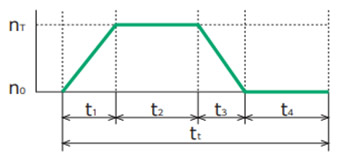
- nT:Maximum output shaft speed (r/min)
- t1:Acceleration time (sec)
- t2:Constant speed time (sec)
- t3:Deceleration time (sec)
- t4:Stopped time (sec)
- tt:Time for 1 cycle (sec.)
Output torque
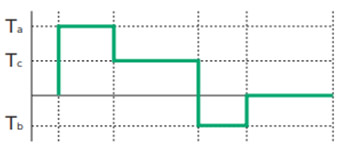
- Ta:Acceleration torque (N・m)
- Tc:Constant speed torque (N・m)
- Tb:Deceleration torque (N・m)
(2) Load moment of inertia Ir
Calculate the load moment of inertia Ir on the output shaft of the reducer from the table for "Determining the moment of inertia".
Ir:Load moment of inertia on the output shaft of the reducer (kg・m2)
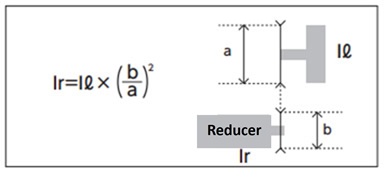
(3) Acceleration torque and deceleration torque Ta, Tb
Acceleration torque Ta = △Ta + Tc
Deceleration torque
△Ta = 2πIr × △na 60 × t1
Tb = △Tb - Tc
△Tb = 2πIr × △nb 60 × t3
- Ir:Load moment of inertia on the output shaft of the reducer (kg・m2)
{Ir + (Ig + Im) × i2}
(Inertia for the motor shaft converted load at reducer + Motor inertia ) × Reduction Ratio ^2 (Moment of Inertia Data ) - △Ta:Inertia acceleration torque (N・m)
- △na:Speed difference (r/min) △na = nT - no
- △Tb:Inertia deceleration torque (N・m)
- △nb:Speed difference (r/min) △nb = nT - no
(4) Constant speed torque Tc
 |
Tc = G(M1 + 2.1 × M2 × L) × μ × r G = Gravitational acceleration :9.80665m/s2 |
 |
Tc = G(M1 + M2) × μ × ℓ 2 × π × η |
 |
Tc = GM × r |
2. Selection procedure
| (1) Calculate the reduction ratio i |
i ≒
Nm
nT
Nm:Motor speed |
||||||||
| ↓ | |||||||||
| (2) Calculate the average output torque |

|
||||||||
| ↓ | |||||||||
| (3) Determine a size
Average torque Maximum torque |
fs:Series-based factor
Maximum torque < maximum torque of the output shaft of the reducer |
||||||||
| ↓ | |||||||||
| (4) Calculate nave., the average output shaft speed |

|
||||||||
| ↓ | |||||||||
| (5) Confirming the rpm nave. × i < rated input speed of the reducer nT × i < maximum input speed of the reducer |
|
||||||||
| ↓ | |||||||||
| (6) Check the output shaft radial load | O.H.L < N:Allowable radial load of the reducer ※ O.H.L = 2000 × Ta × f × Lf D D:Pitch diameter (mm) of sprockets and similar objects (mm) |
||||||||
※See the allowable radial loads in the capacity tables.
f:O.H.L. factors
| Chain | Gear, toothed belt | V-Belt |
|---|---|---|
| 1.0 | 1.25 | 1.5 |
Lf:Point of action factor
| ℓ/Q | 0.25 | 0.38 | 0.5 | 0.75 | 1 |
|---|---|---|---|---|---|
| Lf | 0.8 | 0.9 | 1 | 1.5 | 2 |
Standard length :Q
| Model No. | Reduction Ratio | Q |
|---|---|---|
| DCHM020 | 10 ~ 60 | 36 |
| DCHM040 | 10 ~ 50 | 42 |
| DCHM075 | 10 ~ 50 | 58 |
Series-based factor :fs
| Model No. | Series-based factor |
|---|---|
| DCHM | 1.7 |
Hollow output shaft
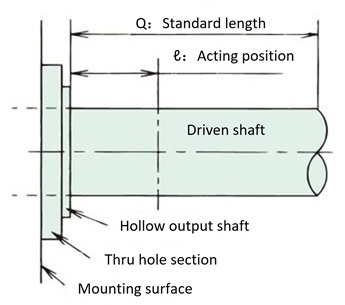
Q:See the tables to the left for the standard length.
Solid output shaft
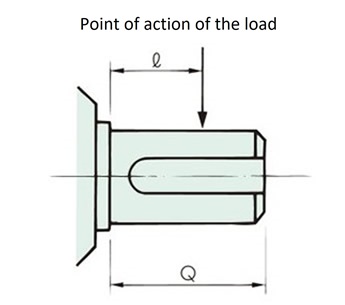
Q:See each type's dimensions for the standard length.
3. Overhang load of the output shaft
When attaching the sprocket, gear, or belt to the output center shaft, or to the hollow shaft using a case tap, confirm that the overhang load acting on the output shaft is equal to or lower than the allowable O.H.L. of the gear motor.
※When using a high-strength toothed belt, do not use the O.H.L. factor shown in Table 1, but take into account the mounting tension in calculating the O.H.L.
[Overhang load calculation ]
Allowable O. H. L. ≧ 2000 × TF × f × Lf Dp
- TF:Correction torque
- f:O.H.L. factor (Table 1)
- Lf:Point of action factor (Formula 1 )
- Dp:Pitch diameter (mm) of sprockets and similar objects (mm)
Standard length :Q
| Model No. | Reduction Ratio | Q |
|---|---|---|
| DCHM020 | 10 ~ 60 | 36 |
| DCHM040 | 10 ~ 50 | 42 |
| DCHM075 | 10 ~ 50 | 58 |
Table 1 .O.H.L. factors :f
| Chain | Gear, toothed belt | V-Belt |
|---|---|---|
| 1.0 | 1.25 | 1.5 |
Formula 1 .Point of action factor :Lf
| ℓ/Q | 0.25 | 0.38 | 0.5 | 0.75 | 1 |
|---|---|---|---|---|---|
| Lf | 0.8 | 0.9 | 1 | 1.5 | 2 |
| Solid shaft | Hollow shaft |
|---|---|

Q:See each type's dimensions for the standard length. |

Q:See the tables to the left for the standard length. |
4. Moment of inertia for the motor shaft converted load
| Model No. | Reduction ratio |
Moment of Inertia ×10-4kg・m2 |
|---|---|---|
| DCHM020-20H | 10 | 0.065 |
| 15 | 0.050 | |
| 20 | 0.045 | |
| 25 | 0.041 | |
| 30 | 0.040 | |
| 40 | 0.039 | |
| 50 | 0.038 | |
| 60 | 0.037 | |
| DCHM040-30H | 10 | 0.117 |
| 15 | 0.076 | |
| 20 | 0.060 | |
| 25 | 0.051 | |
| 30 | 0.047 | |
| 40 | 0.056 | |
| 50 | 0.052 | |
| DCHM075-35H | 10 | 0.306 |
| 15 | 0.209 | |
| 20 | 0.170 | |
| 25 | 0.146 | |
| 30 | 0.140 | |
| 40 | 0.158 | |
| 50 | 0.145 |
| Model No. | Reduction ratio |
Moment of Inertia ×10-4kg・m2 |
|---|---|---|
| DCHM020-22U | 10 | 0.068 |
| 15 | 0.051 | |
| 20 | 0.046 | |
| 25 | 0.041 | |
| 30 | 0.040 | |
| 40 | 0.039 | |
| 50 | 0.038 | |
| 60 | 0.037 | |
| DCHM040-28U | 10 | 0.133 |
| 15 | 0.083 | |
| 20 | 0.065 | |
| 25 | 0.054 | |
| 30 | 0.049 | |
| 40 | 0.059 | |
| 50 | 0.054 | |
| DCHM075-38U | 10 | 0.347 |
| 15 | 0.227 | |
| 20 | 0.180 | |
| 25 | 0.152 | |
| 30 | 0.145 | |
| 40 | 0.165 | |
| 50 | 0.149 |
DCBL Hypoid Motor
| Motor Capacity | Brake |
Moment of Inertia ×10-4kg・m2 |
|---|---|---|
| 0.2kW | No brake | 1.154 |
| With brake | 1.159 | |
| 0.4kW | No brake | 1.753 |
| With brake | 1.780 | |
| 0.75kW | No brake | 12.761 |
| With brake | 12.918 |

